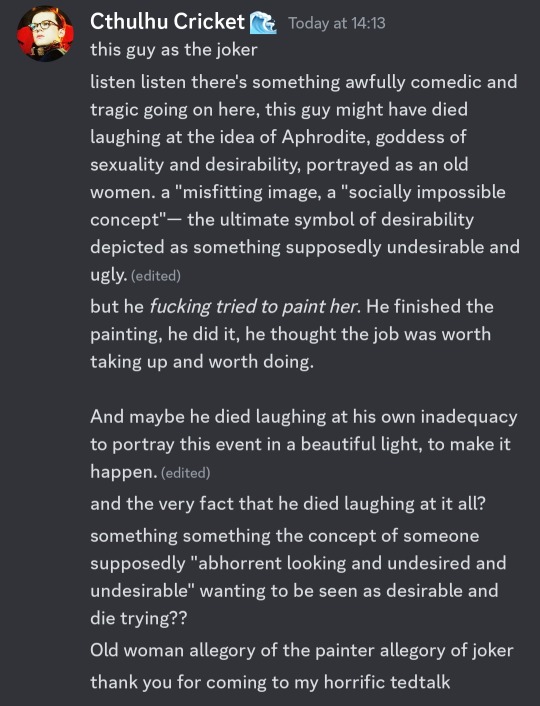#Zeuxis
Text

Quote of the day...
59 notes
·
View notes
Text


The AEW x CMLL partnership continues to grow stronger and stronger with ALL of the BCC going over for a 8 man tag and Willow Nightingale joining in for a 6 woman trios match, hopefully Stephanie Vaquer gets some AEW stuff soon!
Awesome stuff, and Danielson finally gets his dream match against Blue Panther!
#aew#cmll#blackpool combat club#jon moxley#bryan danielson#claudio castagnoli#wheeler yuta#willow nightingale#shame about tessa :/#mistico#blue panther#volador jr#ultimo guerrero#stephanie vaquer#zeuxis#lluvia#La Catalina#tessa blanchard
17 notes
·
View notes
Text


#cmll#homenaje a dos leyendas#willow nightingale#lluvia#zeuxis#stephanie vaquer#tessa blanchard#la catalina
10 notes
·
View notes
Text





😵💫
#Stephanie Vaquer#Willow Nightingale#AEW#CMLL#All Elite Wrestling#La Catalina#Lluvia#Tessa Blanchard#Zeuxis#All Elite#Consejo Mundial de Lucha Libre#AEW Dynamite#AEW Rampage#AEW Collision
16 notes
·
View notes
Text

STEPHANIE VAQUER & ZEUXIS defeat Jarochita & Lluvia to become the inaugural CMLL World Women's Tag Team Champions!
9 notes
·
View notes
Text
Flashback Photoshoot - Zeuxis

11 notes
·
View notes
Photo

Zeuxis Choosing his Models for the Image of Helen from among the Girls of Croton
-
The account of Zeuxis choosing his models is taken from Cicero. Having been commissioned to paint a portrait of Helen of Troy for the Temple of Jupiter at Crotona, the famous Greek artist Zeuxis had to seek the most perfect characteristics from five of the greatest beauties of the city.
#french#art#european art#european#zeuxis choosing his models for the image of helen form among the girls of croton#zeuxis#fine art#europe#brunette#blonde#redhead#artist#greece#rome#italy#mediterranean
10 notes
·
View notes
Text

Eleuterio Pagliano, Zeuxis et les jeunes filles de Crotone (1889)
Au XIXe siècle, les vieilles anecdotes légendaires autour des modèles vivants de la Grèce antique redevenaient à la mode, surtout celles de Phryné et des vierges de Crotone, autrement dit des histoires mettant en scène un artiste grec masculin face à sa (ou ses) modèle féminine, à rebours d’une histoire de la Grèce antique où le nu masculin prédominait.
En voici la démonstration avec une des nombreuses illustrations de la légende de Zeuxis et les filles de Crotone, par Eleuterio Pagliano, qui est un merveilleux prétexte pour représenter, non pas une jeune fille qui "s’offre" à l’artiste, mais cinq d’un coup.
#histoire des modèles vivants#beaux-arts#modèle vivant#life models#anatomie#artists’ models#modèle d’arts plastiques#peinture#Grèce antique#Zeuxis#paintings
0 notes
Text




I am a radiant being
of light and healing
I feel peace
I am safe
we heal from a whole place
#nemrud#lion#star#hedy lamarr#quote#hymn#of#healing#beautiful#chorus#zeuxis#changed a word#kappadokien#ΚΑΠΠΑΔΟΚΙΑ#türkiye
0 notes
Text
Caius Petronius Arbiter – Satyricon, 3, LXXXIII
In pinacothecam perveni vario genere tabularum mirabilem. Nam et Zeuxidos manus vidi nondum vetustatis iniuria victas, et Protogenis rudimenta cum ipsius naturae veritate certantia non sine quodam horrore tractavi. Jam vero Apellis quam Graeci monkthmon appellant, etiam adoravi. Tanta enim subtilitate extremitates imaginum erant ad similitudinem praecisae, ut crederes etiam animorum esse picturam.
Hinc aquila ferebat caelo sublimis Idaeum, illinc candidus Hylas repellebat improbam Naida. Damnabat Apollo noxias manus lyramque resolutam modo nato flore honorabat. Inter quos etiam pictorum amantium vultus tanquam in solitudine exclamavi: «Ergo amor etiam deos tangit. Iuppiter in caelo suo non invenit quod diligeret, sed peccaturus in terris nemini tamen iniuriam fecit. Hylan Nympha praedata temperasset amori suo, si venturum ad interdictum Herculem credidisset. Apollo pueri umbram revocavit in florem, et omnes fabulae quoque sine aemulo habuerunt complexus. At ego in societatem recepi hospitem Lycurgo crudeliorem.».
[HIS] Llegué a una sala de pintura con maravillosos cuadros de diversos estilos. Admiré la mano de Zeuxis en aquellas de sus tablas que la injuria del tiempo no había logrado todavía destruir; también vi bocetos de Protógenes, que competían en realismo con la propia naturaleza y que yo no podía tocar sin sentir cierto sobrecogimiento. Adoré también a la diosa de Apeles que los griegos llaman Monocnema. El contorno de las figuras destacaba con tal primor y naturalidad, que las figuras parecían tener vida. Por un lado, un águila planeaba en el cielo llevándose al escanciador del Ida; por otro lado, el inocente Hylas rechazaba a una Náyade impúdica. Apolo maldecía su brazo asesino y adornaba con un capullo entreabierto su lira por tensar. También había unos cuadros con figuras de enamorados; yo, como si estuviera solo, exclamé: «Así, pues, hasta los dioses se enamoran. Júpiter no halló en todo su cielo el objeto de su amor; por eso bajó a la tierra a satisfacer su pasión, pero sin perjudicar a nadie. La Ninfa que raptó a Hylas hubiera dominado su pasión si hubiera pensado que Hércules vendría a reclamar sus derechos sobre ese joven. Apolo hizo revivir en una flor la sombra del joven Jacinto; y todas las fábulas están llenas de amores sin rivalidades. Pero yo admití como socio de mi vida a un huésped más cruel que Licurgo.».
#Petronius Arbiter#Satyricon#saec. I#scriptum#Zeuxis#Protogenes#Apelles#Naida#Hylas#Apollo#Iupiter#Nympha#Hercules#Hyacinthus#Lycurgus#Lisardo Rubio Fernández
1 note
·
View note
Text
“But where employees are a corporation’s key assets, workers’ greater power comes in threatening to – or actually – walking out the door”.
0 notes
Text

12 notes
·
View notes
Text


2 notes
·
View notes
Text


so, what do Zeuxis the greek painter, an overconfident old lady and DC's Joker have in common? AKA i have a batjokes fic idea
#people are lucky they dont wake up on an absolutely uneventful Friday morning#to me plotting the most unhinged Joker characterizations in their inbox without any previous warnings#not Asty though; Asty is not lucky at all#Anyway i'm keeping this one. in a metaphorical way#dc joker#batjokes#because yeah#Farimah writes
36 notes
·
View notes
Text

Jacques-Albert Senave - Le Marché de la Vallée, vers 1815 - 1815
Jacques-Albert Senave (1758–1823) was a Flemish painter mainly active in Paris during the late 18th and early 19th centuries. He is known for his genre scenes, history paintings, landscapes, city views, market scenes and portraits.
Senave is known for his genre scenes, history paintings, landscapes, city views, market scenes, portraits and some still lifes. His genre paintings were strongly influenced by seventeenth century Flemish and Dutch genre scenes. These are particularly reminiscent of David Teniers the Younger's tavern and festival scenes. He excelled especially in anecdotal representations of daily life, market scenes, village views.
Senave painted two versions of a work entitled Parody of Zeuxis (Royal Museums of Fine Arts of Belgium, Brussels and City Museum of Ypres) which are a parody on a legend about the Greek painter Zeuxis who flourished during the 5th century BCE. The story as recounted by Cicero states that Zeuxis received a commission to paint a portrait of Helen of Troy for the Temple of Jupiter at Crotona. To realise the commission Zeuxis set out to find the most perfect characteristics from five of the greatest beauties of the city. In Senave's painting in the Royal Museums of Fine Arts of Belgium, the artist is shown sitting in a cavernous space with a large canvas in front of him while he is inspecting prospective models in various states of undress. An old lady behind the models looks like a procuress, which suggests that in fact the models are prostitutes and the room is a brothel. This impression is further bolstered by the pair of lovers huddled furtively on the right side. Some suspicious figures are gathered in the shadow on the far left, one of whom is holding a painting. Art historian Elizabeth Mansfield has described the dog standing in front of Zeuxis as misshapen and a likely product of the same method of selecting and combining traits of dogs as Zeuxis intended to use with his models. The method clearly did not produce an example of ideal beauty. Mansfield writes that the painting "humorously exposes the circuit of aesthetic-erotic-commercial traffic embedded within the Zeuxis myth".
Senave painted religiously themed works such as the Seven Works of Mercy created for the Saint Peter's church in his hometown Lo. He only painted a few portraits. An example is the Portrait of a 48-year old gentleman (Sotheby's Amsterdam 5 May 2009, lot 101). It shows the unidentified sitter seated in his study with his right arm resting on a book on a small table. The book tells something about the sitter's beliefs: it is didactic poem, Altaergeheimnissen (Dutch for 'Secrets of the Altar') first published 1645 in which the Catholic convert Joost van den Vondel expounded the doctrine of the Eucharist.
13 notes
·
View notes
Photo

François-André Vincent (French, 1746–1816)
Zeuxis Choosing his Models for the Image of Helen from among the Girls of Croton, c.1791
#François-André Vincent#french#france#zeuxis choosing his models for the image of helen from among the girls of croton#art#fine art#greece#rome#italy#crete#mediterranean#western civilization#brunette#blonde#redhead#oil painting#zeuxis#european art
8 notes
·
View notes